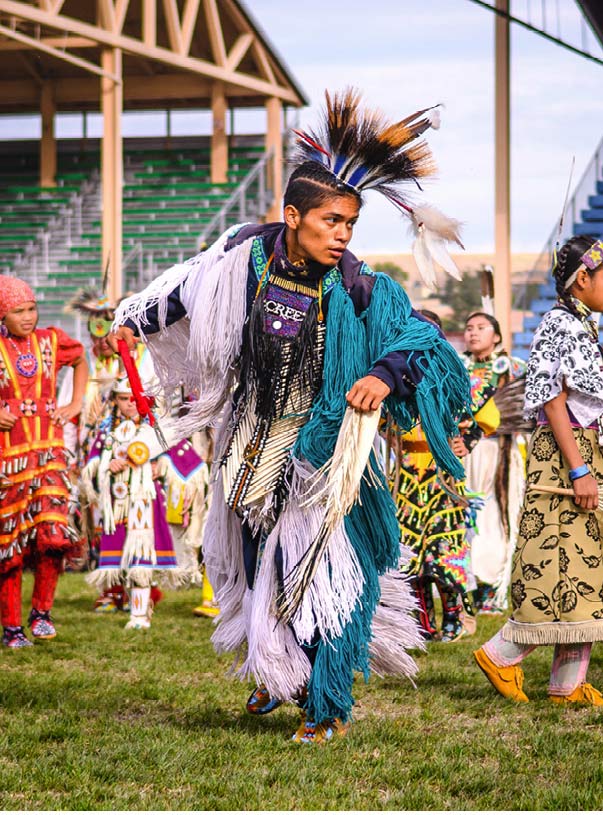Rodeo Culture
by Adam Sawyer
The American rodeo, like so many other ingrained aspects of culture across this continent, has its roots in a melding of customs and traditions. With heavy American Indian as well as Spanish and Mexican influence from the vaqueros’ the word “rodeo” comes from the Spanish word “rodear” meaning “to surround” or round up—early Anglo pioneers adopted and adapted skills to run a ranch and usher in the era of the American cowboy in the 1800s. Ranch competitions showcasing everyday skills required to be a cowboy became increasingly popular with time, eventually leading to the professional rodeo format still used today. Professional rodeos in America consist of two types of competitions: roughstock events and timed events.
Roughstock events include bareback riding, saddle bronc riding and bull riding. A contestant’s score is equally dependent upon a rider’s performance and an animal’s performance. In timed events such as steer wrestling, team roping, tie-down roping, barrel racing and steer roping, cowboys and cowgirls compete against the clock as well as against each other. Points and times are then tallied and tabulated, culminating with the crowning of an all-around winner. Today the rodeo tradition continues, especially in the West where some of the most renowned and respected rodeos continue to draw spectators from around the country and around the globe.
Pendleton Round-Up
This Pendleton, Oregon rodeo has become an iconic event with a long history. Following a July Fourth celebration in 1909 that consisted of bronc riding, horse races, feasts, foot races and fireworks, the idea of an annual event to be known as the Pendleton Round-Up was spawned. It was also around that time that the “Let’er Buck” slogan—symbolic of the Round-Up—was inspired. The following year the event was billed as, “A frontier exhibition of picturesque pastimes, Indian and military spectacles, cowboy racing and bronco busting for the championship of the Northwest.” It has only grown from there.
Beyond the competitive aspects of the event, a strong Native American presence and participation have been a large component of the event from the beginning. For more than a century, the onsite Indian Village has been a hub of activity for the Native community during Round- Up Week. There, traditional tipis are set up predominantly by members of the Confederated Tribes of the Umatilla Indian Reservation, and sites can be handed down from generation to generation to occupy the same familial spot within the village in perpetuity. Today, the village is home to roughly 300 of the Indian shelters and is the largest annual Native encampment in North America.

The Ellensburg Rodeo
The Ellensburg Rodeo takes place Labor Day weekend in Ellensburg, Washington, and corresponds with the Kittitas County Fair. A multitude of festivalgoers choose to make the most of their long weekend by partaking in both events. This year, the festivities are bound to be robust as the rodeo celebrates its 100-year anniversary. It is regularly ranked as one of America’s Top 10 professional rodeos, attracting the best riders, ropers and wrestlers.
Considered one of the “old rodeos,” it was started by a diverse group of ranchers, farmers, American Indians and community-minded citizens in an effort to celebrate a “vanishing frontier way of life.” Today, the Friday night opening performance starts in the early evening and ends under the stars. Saturday and Sunday afternoon performances transpire beneath daytime skies and lead up to the Labor Day Monday Championship Finals, often referred to as, “The best of the best dueling in the dirt.”
The Snake River Stampede
From its first iteration as the 1913 Nampa Harvest Festival, this bucking contest is now known as the Snake River Stampede in Idaho. As this rodeo has morphed through the years, it has become not only a rodeo but a true entertainment spectacle as well. Country music superstars such as Reba McEntire and Glen Campbell have headlined the event, which now attracts tens of thousands of fans from across the country each year, ranking it as one of the Top 10 PRCA rodeos in the United States.
Beyond the megawatt star power provided by wranglers and musicians, the stampede itself gives to local charities on a scale just as grand, which includes various military organizations. The Snake River Stampede Junior Rodeo helps pass the traditions onto future generations by giving them the opportunity to compete in the same venue as the pros, and teaches them responsibility and sportsmanship. Likewise, its program Stampede for the Cure helps provide women with mammograms and raises funds to fight breast cancer. The program and rodeo have raised $700,000 since 2006 to help provide services throughout the Treasure Valley.
Cheyenne Frontier Days
In Wyoming, Cheyenne Frontier Days, also known as the “Daddy of ‘Em All,” has been kicking up dust with the world’s largest outdoor rodeo and Western celebration since 1897 and is one of the oldest rodeos in the world. What started as a roundup that featured bronco-busting contests and pony races, today draws top professionals who compete for more than $1 million in cash and prizes. Complementing the daily rodeo action are behind-the-scenes tours, trick riding and a wild-horse race. In addition, Native American traditions are featured in the Indian Village. Other features include a chuck wagon cook-off, pancake breakfast and an art show to help round out the frontier theme. Meanwhile, attendees can also enjoy a carnival, top-name entertainment, professional bull-riding shows, and several parades that include antique carriages and automobiles. Looking to the skies, there is an annual appearance by the United States Air Force Thunderbirds Air Demonstration Squadron.
Adam Sawyer is an outdoor and travel writer, photographer and guide based in the Northwest. His work has appeared in Northwest Travel & Life, Backpacker, and several British Columbia magazines. His guidebooks include Hiking Waterfalls in Oregon, Unique Eats and Eateries: Portland, Oregon, Best Easy Day Hikes Salem and Eugene, and Urban Hikes Oregon.

